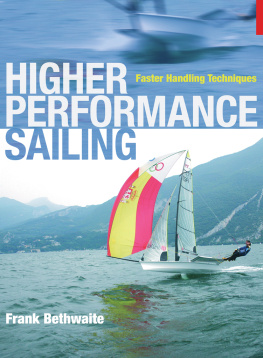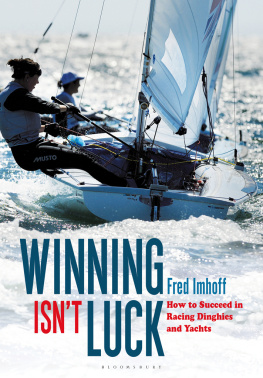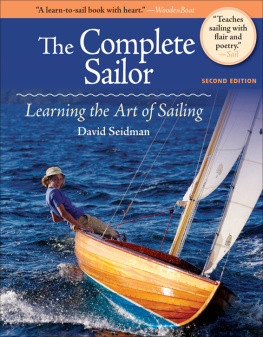
2006 World 29er Champions Silja Lehtinen and Scott Babbage sailing a 29erXX in a fresh breeze.





High Performance Sailing, published in 1992, describes how the wind works, how the waves work, how the conventional boat works, and how to shape and trim sail for best VMG (velocity made good) in different winds and waves.
Higher Performance Sailing, published in 2008, introduces the apparent wind sailboat and describes how its more complex dynamics meshes with new discoveries about the wind to tack downwind at three times the boat speed of its predecessors.
Apparent wind sailing
Ice yachts have been able to tack downwind at four or five times wind speed for 100 years, but there are so few of them, and so little about them appears in the media, that to the worlds wet-water sailors they have always been mystery boats. How to sail them has been regarded as an irrelevant black art that was just that a skill not relevant to real sailors.
In the decades from 1970 to 1990, the Eighteen footer skiffs of Sydney adapted iceboat technology to wet-water sailing and tripled their downwind speeds. The new spectacle of these skiffs flying down the harbour at unprecedented speed attracted big harbourside and ferry spectator crowds, and within a few years this exciting new style had expanded into a sports television programme which achieved top prime-time ratings.
The phrase apparent wind sailing was coined, and apparent wind sailing technique was promoted from irrelevant black art to legitimate curiosity.
In 1996 the unthinkable happened the skiff-derived 49er was selected as the Olympic pinnacle class to bring spectacle to Olympic sailing, and in 1998 the 49er was followed by the 29er, a youth trainer that sails like a skiff to train for a skiff. Within a year, the 29er was being built in six countries worldwide, and quickly became one of the two world youth trainers.
The designers of bigger boats are now adopting the technology developed by the skiffs to the point where a new genre of big swing keel apparent wind monohulls of Americas Cup and Volvo size, and big multihulls, can also fly downwind at unprecedented speeds.
Quite suddenly, the apparent wind revolution has become global, and apparent wind sailing and handling technique has become very relevant indeed.
Higher Performance Sailing
In 1998, at the time of the second (of five to date) reprints of High Performance Sailing (HPS-1), I was requested by the publishers to revise it to cover the new science and technique of apparent wind sailing.
As the work began to take shape, it became evident that the scope, extent and difference of the new material was more than could properly be accommodated within an internal revision. So what started as a revision has developed into this new work that extends and refers to, but does not repeat, HPS-1.
Higher Performance Sailing (HPS-2) introduces three new areas of sailing art to the sailor who wants to excel, and who wants to know what he would be letting himself in for if he made the change from blow-downwind to tack-downwind sailing.
Technology
The first part of this book introduces the apparent wind sailboat.
Chapters 1 to 22 explain the history and the evolution of high performance conventional sailing, and then of apparent wind sailing, to the sailor who wants to understand the technical background of this new way of sailing faster. It explains:
How the wind works at three levels of its spectrum which have previously been little studied or discussed.
How apparent wind boats work the light strong materials from which they are made, the construction methods used, and the new dynamic principles involved in their design, rigging and handling; all of which work together to make the new performance levels possible.
Handling
The second part of HPS-2 introduces the discovery that, at the subconscious level, two parallel handling techniques have coexisted for many decades. Natural handling technique is used, completely unconsciously, by the great majority of sailors. These are the sailors who always follow and never win. Fast handling technique is used, equally unconsciously, by the few champion sailors who always lead and share all the wins.
Consciousness of the importance of this as a separate subject area arose as a direct consequence of the much higher speeds at which the new boats sail.
The smaller apparent wind sailboats the B-14, 29er and 59er (and no doubt others that I do not know) are truly delightful, fast and exciting boats to sail, and are simple to handle in the same sense that it is simple to ride a bicycle or use a pair of skis once you have learned how to do it.
I have introduced large numbers of mature sailors who are still young at heart to these faster sailboats. The high point is to hoist the spinnaker and feel the boat accelerate and settle into its faster than the wind tack-downwind mode of sailing. But both the sailors and I have been surprised to find that most of them experienced a totally unexpected difficulty. What was happening was that they had never previously handled any boat that could sail at sustained, really high speed, so had never learned either the balance techniques necessary to handle all fast sailboats, or the co-ordination necessary to handle any sailboat at real speed.
A few years later, much the same phenomenon arose with motivated sailors of conventional boats who improved their handling skills on the sailing simulator, but also experienced unexpected difficulty when they returned to the water with a new capability to sail at speed.
Access to the sailing simulator has been like having access to a microscope where previously the view has been through frosted glass. This has enabled me to look more closely at the handling component of sail training, and from there to look at the whole of sailing itself. This has led to the seminal identification of the slower natural and the faster fast handling techniques, both of which coexist at the subconscious level and that we can now see have been responsible for so much woe in past years.
At root, natural handling technique is quick and easy to learn because no co-ordination is called for and its luff for everything control of roll is consistent; this is why the great majority of sailors have learned natural handling and sail this way. But this simplicity comes at a cost:
Because natural handling is intrinsically slower than fast handling, natural sailors follow for all of their lives and never lead in, nor win, important races.
Because fast handling technique as applied to both conventional and apparent wind sailboats necessarily involves the balance of the cyclist, the skater or the skier, and because the natural sailor has never learned this skill, this is why he or she characteristically has difficulty in controlling any boat either in strong winds or at real speed. This also explains the unexpected initial difficulties of motivated sailors in controlling the smaller, but still very fast, apparent wind sailboats.
Next page











